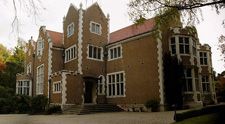Olveston
Olveston is a large mansion in the inner suburb of
Dunedin, New Zealand that was constructed between 1904 and 1907 for
a rich merchant named David Theomin, who had come here from the
village of Olveston, South Gloucestershire, England. David would
marry Marie Michaelis of Melbourne and become related to the
extended de Beer, Fels, Brasch and Hallenstein families of Dunedin,
who were patrons of the arts and learning. Charles Brasch, a New
Zealand poet and editor would say of David that "he was a jolly
bouncy little man who liked a bit of swank perhaps but was kindly
and quite without side". David's fortune would come from his import
business of pianos that he would sell in the nation in a chain of
shops called the Dresden, and eventually be called the Bristol Piano
Company. He and his daughter would become patrons of the music and
visual arts. The house was constructed in the Jacobean style using
plans drawn up by London architect, Sir Ernest George, and fitted
with all the newest conveniences that included a food mixer,
elevator, internal telephone system, central heating and electric
toaster among others, with 35 rooms and some 30,000 square feet of
space. He had purchased the land in 1881, with an existing villa,
and by 1901 had purchased the adjacent property, and then, in 1904,
he would buy another, with their existing structures taken down. The
structure is brick with Moeraki gravel, using Oamaru stone facings
and roofed with Marseilles tiles. The Theomins would collect art,
furniture and ceramics, with an outstanding Japanese collection with
materials and works by Frances Hodgkins, Frank Brangwyn, W. M.
Hodgkins and Alfred Henry O'Keefe. David's daughter, Dorothy would
leave the estate to the city in 1966 and opened as a museum house
the next year. With its architectural significance, collection and
record, it showcases the life of the wealthy in Edwardian New
Zealand during that period.
|

